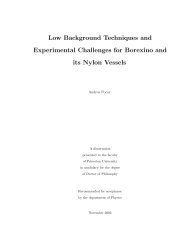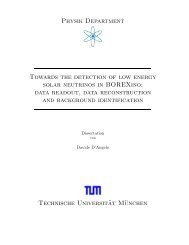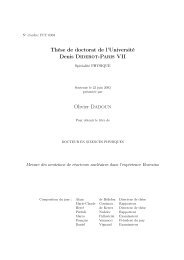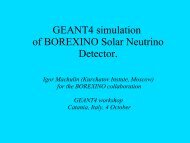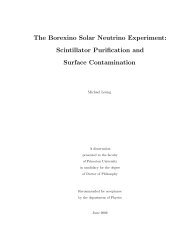Development of a Liquid Scintillator and of Data ... - Borexino - Infn
Development of a Liquid Scintillator and of Data ... - Borexino - Infn
Development of a Liquid Scintillator and of Data ... - Borexino - Infn
Create successful ePaper yourself
Turn your PDF publications into a flip-book with our unique Google optimized e-Paper software.
4.2 The Tracking <strong>of</strong> the Scintillation Photons<br />
Figure 4.4: In the left picture the shape <strong>of</strong> the BOREXINO concentrators is shown. In the right<br />
picture the angular acceptance <strong>of</strong> this cone shape is shown.<br />
Ñ Ñ ¢ reflectivity 92 % ) [Obe01]. The shape <strong>and</strong> the angular acceptance <strong>of</strong><br />
the light concentrators are shown in fig. 4.4.<br />
PMT Quantum Efficiency, Time Jitter <strong>and</strong> Counting Statistics<br />
The PMTs used in the CTF as well as in BOREXINO are the 8” Thorn EMI 9351 photomultipliers.<br />
Their characteristics are: high quantum efficiency (26 % at 420 nm), limited transit time<br />
spread ( ns), good pulse height resolution for single photoelectron pulses (peak/valley<br />
2.5), low dark noise rate (1 kHz), low after pulse probability (2.5 %), gain . The quantum<br />
efficiency <strong>of</strong> the photo cathode <strong>of</strong> the PMT is shown in fig. 4.5. A typical pulse height distribution<br />
<strong>of</strong> single photoelectron pulses <strong>and</strong> the transit time distribution is shown in fig. 4.6 for one<br />
<strong>of</strong> the PMTs used in BOREXINO. In the simulation, if a photon hits a PMT, the probability for<br />
areflection at the water-glass interface is calculated. If the photon is not reflected, it creates a<br />
photoelectron with a probability according to the PMT quantum efficiency. The pulse height<br />
signal is calculated according to a Poisson distribution. For the time signal, the transit time <strong>of</strong><br />
the PMT has to be taken into account. The mean transit time is 4.5 ns, with a Gaussian time<br />
jitter <strong>of</strong> 1 ns.<br />
The Tracking Program<br />
The data flow <strong>of</strong> the tracking program is outlined here for BOREXINO (the tracking in the CTF<br />
is analogous):<br />
1. The tracking algorithm starts with the generation <strong>of</strong> a scintillation photon at the position<br />
51



